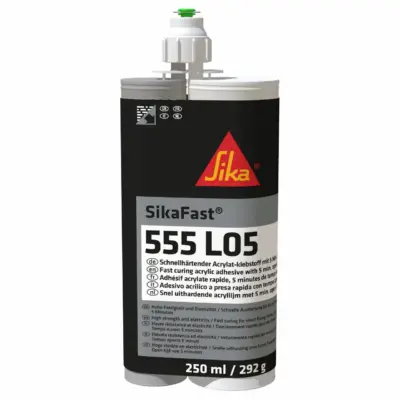Adhesives
Best Adhesive For Structural Joints
Best Adhesive For Structural Joints In Engineering
Selecting the right adhesive is critical for creating durable, high-strength structural joints in engineering applications across industries like construction, infrastructure, mining, automotive, aerospace and more.
The adhesive must be able to withstand dynamic stresses, impacts, vibration, fatigue and Australia’s harsh climate while firmly bonding dissimilar materials such as metals, composites, plastics and concrete.
Leading manufacturer Sika provides a wide range of high-performance structural adhesives in Australia engineered specifically for strength, resilience and flexibility.
In this comprehensive article, we will explore three of Sika’s advanced adhesive systems – SikaFast® acrylic, SikaPower® epoxy and SikaForce® polyurethane adhesives. It examines their unique properties, performance benefits and ideal applications for structural joints.

Acrylic Adhesives – SikaFast® Range
SikaFast®-5000 series comprises rapid-curing, flexible acrylic-based structural adhesives that cure independently of moisture through acrylic polymerisation. This reaction enables quick strength build-up, which is vital for bonding in Australia’s fluctuating construction conditions.
SikaFast® utilises Sika’s patented ADP technology (Acrylic Double Performance) derived from cutting-edge acrylic chemistry. ADP enhances traditional acrylic properties with:
- Very rapid strength development and short handling times
- Ability to strongly bond thinner and lighter material combinations
- High lap shear and tear strength
- Excellent UV light exposure resistance
- Tenacious adhesion to diverse substrates
- Low odour
- High strength and flexibility
Applications
With their resilience and rapid cure, SikaFast® adhesives are ideal for structural joins across Australian infrastructure, construction, mining and manufacturing, where dynamic load performance is critical.
Their flexibility and ability to bond lightweight mixed material combinations also make SikaFast® suitable for structural joints in composite components, vehicle bodies, rail cars, wind turbine blades and more.
Specific applications include:
- Structural bonding of profiles, panels and frames in infrastructure and construction
- Assembling mining equipment and machinery
- Joining fibre-reinforced plastics, composites and metals in manufacturing
- Automotive and rail car assembly
- Wind turbine rotor blade and tower bonding
- Structural woodworking joints
- General metal, plastic and composite fabrication
Benefits for Australian Conditions
SikaFast® acrylic adhesives provide important performance benefits for Australia’s harsh environments:
- Cures rapidly to reach handling strength quickly, even in fluctuating humidity and temperatures
- Withstands prolonged exposure to UV rays, which is critical for exterior structural applications
- Maintains bond strength and flexibility across heat variations and thermal cycling
- Resilient to shocks, vibration and dynamic cyclic loads
- Bonds dissimilar materials like composites, plastics, metals and wood
- Does not require special surface treatments
- Can bridge gaps up to 5mm in less-than-ideal joints
Epoxy Adhesives – SikaPower® Range
The SikaPower® range comprises high-strength, two-part epoxy adhesives engineered for rigid substrate bonding across engineering and construction applications. SikaPower® adhesives provide:
- Tenacious adhesion to concrete, metals, composites and wood
- Very high bond strength and stiffness
- Minimal creep under prolonged static loads
- Exceptional fatigue and impact resistance
- Excellent chemical and corrosion resistance
- Long-term durability in harsh Australian conditions

Applications
SikaPower® epoxies are ideal for structural joints under highly sustained static loads across civil and mechanical engineering projects. SikaPower®-1500 provides outstanding adhesion for structural assembly in large steel and concrete structures, bridges, staging, cranes, mining equipment and more.
SikaPower®-1200 has even higher impact/fatigue resistance for dynamic machine joints in heavy equipment. SikaPower’s exceptional creep, chemical and fatigue resistance make it suitable for exposed structural joints across infrastructure assets like power plants, wastewater treatment facilities, and coastal structures.
Benefits for Australian Conditions
SikaPower® epoxy adhesives deliver critical performance benefits:
- Maintains extremely high bond strength in wet, humid and alkaline environments
- Provides excellent corrosion protection in coastal and marine settings
- Handles high-temperature variations and extreme thermal fatigue
- High creep resistance under heavy static loads over decades
- Withstands shocks, impacts and vibrations in equipment and machines
- Superb chemical and abrasion resistance in harsh environments
- Durable fatigue life across many years of continuous use
Enjoying This Article? Read: The 10 Best Deck Stains
Polyurethane Adhesives – SikaForce® Range

SikaForce® two-part polyurethane adhesives provide an unmatched combination of high strength and elasticity for bonding composites, plastics and metals. Key properties include:
- Excellent elongation, peel, shear and tear strength
- Superior dynamic fatigue, impact and crack resistance
- Minimal odour for shop-floor use
- Ability to join dissimilar materials
- Excellent ageing resistance and chemical durability
Applications
With their versatility, SikaForce® adhesives are ideal for joining lightweight and mixed-material assemblies across manufacturing. Their high elasticity and shear strength ensure durability in dynamic environments, making SikaForce® suitable for interior and exterior joints in vehicles, railcars, caravans and hulls that must handle constant vibration, shocks and stress.
SikaForce® is also commonly used in Australian defence, aerospace, leisure products and other advanced manufacturing sectors where high-performance, lightweight structural bonding is needed.
Benefits for Australian Conditions
- Maintains adhesive strength and flexibility across temperature variations
- Handles sustained vibration, long-term fatigue and repetitive impacts
- Resists alkaline, acidic, salt water and chemical environments
- Bonds plastics, composites, metals and other dissimilar materials
- Provides consistent, reliable performance bonding across factories
Comparing Sika’s Structural Adhesives
| Adhesive | Description | Key Strengths | Typical Applications |
| SikaFast® | Acrylic, fast-curing, resilient | – Rapid strength development
– Bonds dissimilar – Dynamic/fatigue resistance |
– Infrastructure
– Construction – Manufacturing |
| SikaPower® | High-strength epoxy | – Extremely high bond strength
– Static load resistance – Corrosion resistance |
– Civil engineering
– Infrastructure – Heavy equipment |
| SikaForce® | Polyurethane, elastic, strong | – Fatigue and impact resistance
– Lightweight material bonding – Chemical resistance |
– Automotive
– Aerospace – Manufacturing |
Enjoying This Article? Read: 11 Best Deck Cleaners
FAQs
What are some common applications for structural adhesives?
Structural adhesives are used to bond load-bearing joints in many industries like construction, infrastructure, aerospace, automotive, marine, and general manufacturing.
Typical applications include bonding lightweight composites and metals in aircraft, joining aluminium and steel components in bridges and buildings, assembling cars, trucks, railcars, and ships, and fabricating wood structures.
What factors should be considered when selecting a structural adhesive?
Consider the materials being joined, required bond strength, need for impact or fatigue resistance, operating environment, cure conditions, pot life, ease of application, and cost. Match the adhesive’s properties to the application requirements.
What adhesive types are commonly used for structural bonding?
Epoxies, acrylics, polyurethanes, and modified silicones are all used. Epoxies provide extremely high bond strength.
Acrylics offer fast cure and weathering resistance. Polyurethanes give high strength combined with flexibility. Silicones withstand high and low temperatures.
How strong can bonded structural joints be compared to mechanical fasteners?
Properly designed adhesive joints can match or exceed the strength of bolted or riveted joints.
Adhesives evenly distribute stresses and avoid point loads. The bonded joint strength depends on adherend surface preparation, adhesive selection, joint design, and cure conditions.
What should be done to prepare surfaces prior to adhesive bonding?
Surfaces should be cleaned to remove contaminants. Abrasion or chemical etching may be required to promote mechanical interlocking and adhesion. Pretreatments are often needed for plastics, composites and metals. Primers can also be used.
How are structural adhesive joints tested and qualified?
Adhesive joints undergo standardised mechanical tests to measure strength, toughness, fatigue resistance, creep, and durability.
Testing validates joint performance under real-world conditions like humidity, temperature extremes, and long-term loads. Computer modelling and destructive pull-off tests also evaluate bond integrity and strength.
Conclusion
SikaFast®, SikaPower® and SikaForce® represent leading structural adhesive solutions for Australian engineering across infrastructure, construction, mining, automotive, aerospace and diverse manufacturing industries.
SikaFast® acrylic adhesives provide resilient, flexible, high-performance bonding for dynamic and fatiguing loads. SikaPower® epoxies give maximum strength for extremely heavy static stresses. SikaForce® polyurethanes deliver elite fatigue and impact resistance when joining lightweight composites and mixed material assemblies.
By considering the specialised properties of each Sika adhesive technology, engineers can optimise the structural durability, lifecycle cost and safety of critical bonded joints and assemblies under Australia’s uniquely harsh environments. Sika continues to pioneer cutting-edge, high-strength adhesives that withstand the demanding requirements of the Australian industry.
